LeGenD
MODERATOR

- Joined
- Aug 28, 2006
- Messages
- 15,813
- Reaction score
- 162
- Country
- Location
BACKGROUND
North Korea and South Korea were split across the 38th parallel by USSR and USA after World War 2.

USSR helped transform North Korea into an organized communist state with well-equipped armed forces in the (1945 - 1950) period.
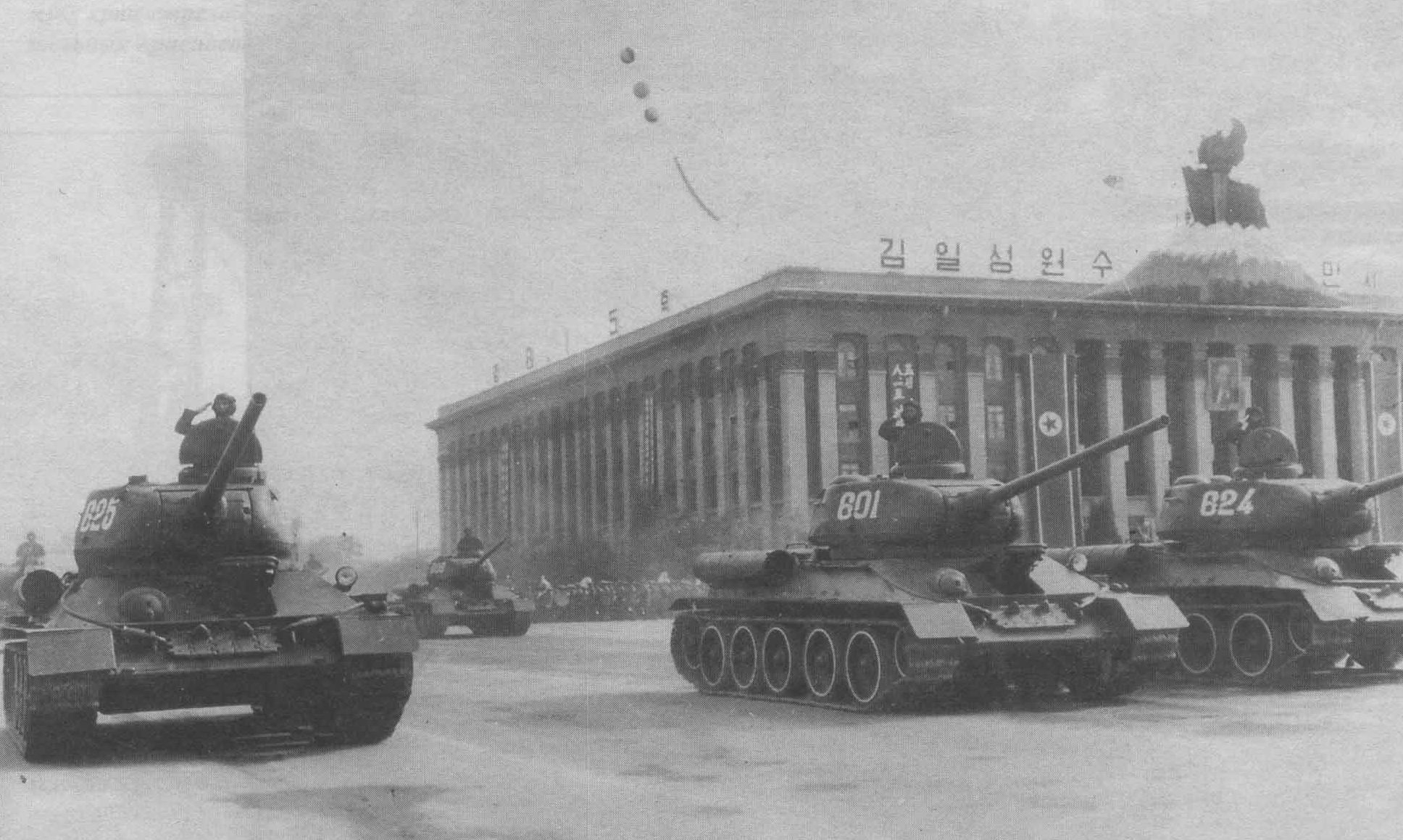
USA did not pay much attention to security needs of South Korea and reduced its footprint in the region to significant extent. In view of this development, Soviet Leader Joseph Stalin felt that South Korea can be taken by force and USA will not defend it.
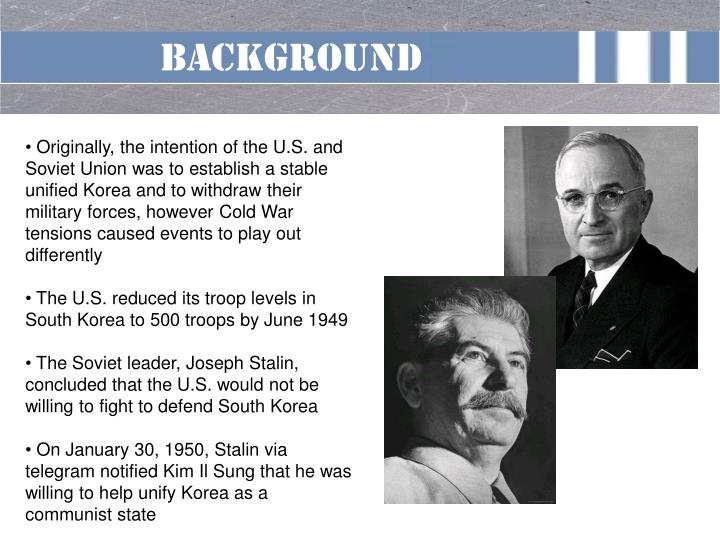
American armed forces were also subject to downsizing back home:
 apps.dtic.mil
apps.dtic.mil
THE WAR
Broader perspective:
Tanker's perspective:

PHASE 1
Detailed (visual) information in following link: https://history.army.mil/reference/Korea/KW-P1.pdf
North Korea invade South Korea on June 25, 1950; much of South Korea is overrun in the span of some months.

North Korean army was in possession of T-34-85 main battle tank(s) in 1950 which was better than a number of American counterparts with the exception of M-26A1 Pershing at the time.
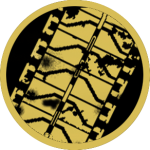 tanks-encyclopedia.com
tanks-encyclopedia.com
North Korean army also fielded thousands of artillery pieces including katyusha rocket launchers to bombard enemy positions.
North Korean Air Force was equipped with battle-proven Yak-9 variants.
South Korean Pusan Perimeter was able to hold its ground nevertheless.

 youtu.be
youtu.be
PHASE 2
Detailed (visual) information in following link: https://history.army.mil/reference/Korea/KW-P2.pdf
US-led forces emerge in force and liberate South Korea under the command of General Douglas MacArthur; Operation Chromite is a masterstroke move on September 25, 1950 in relation.
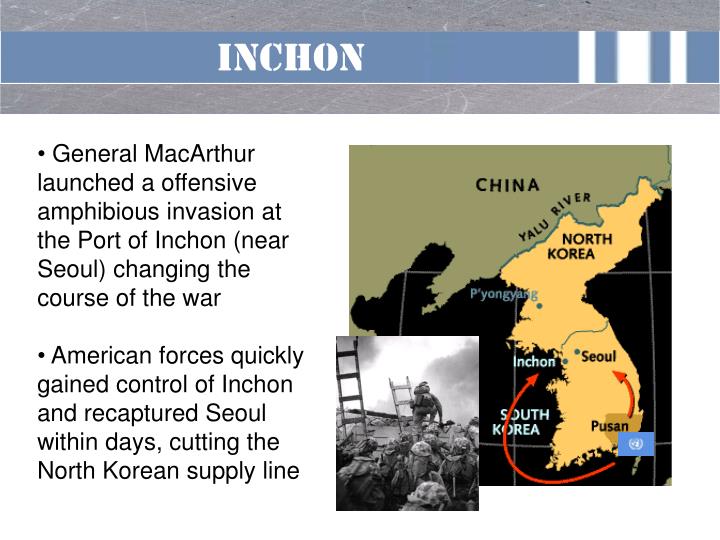
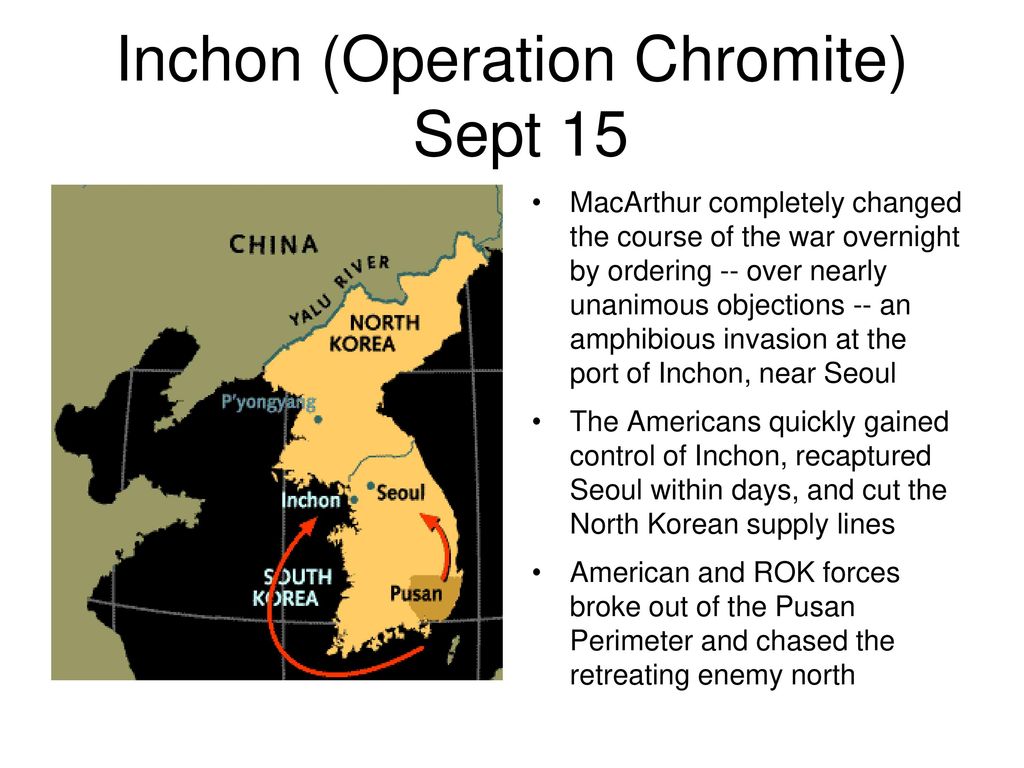

 www.businessinsider.com
www.businessinsider.com
US-led forces rout North Korean military from South Korea, and invade North Korea after a gap of some days and approach Yalu River.
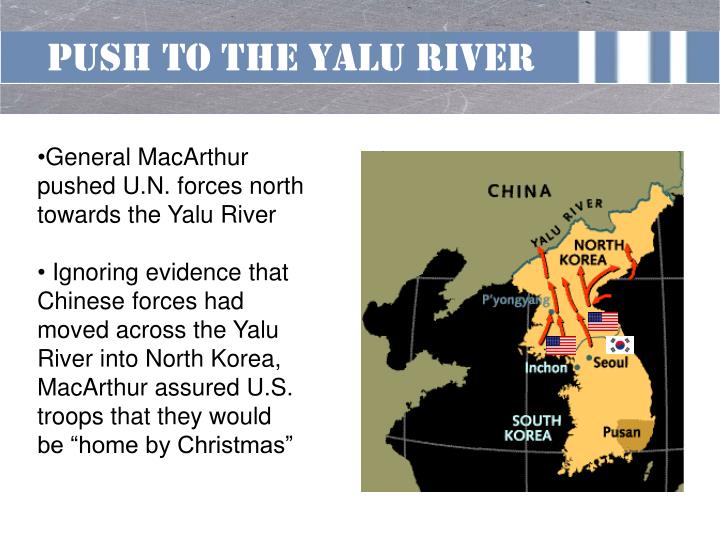
The role of heavy artillery in deployments of US-led forces for reference:
In response to deployment of the impressive F-86 variants by USAF in the region to defeat North Korean Air Force, USSR dispatched the impressive MiG-15 variants to the Korean front. This was the only war in history in which Soviet Air Force and USAF fought each other directly.
 youtu.be
youtu.be
PHASE 3
Detailed (visual) information in following link: https://history.army.mil/reference/Korea/KW-P3.pdf
China dispatch a massive army to liberate North Korea in a significant turn of events.
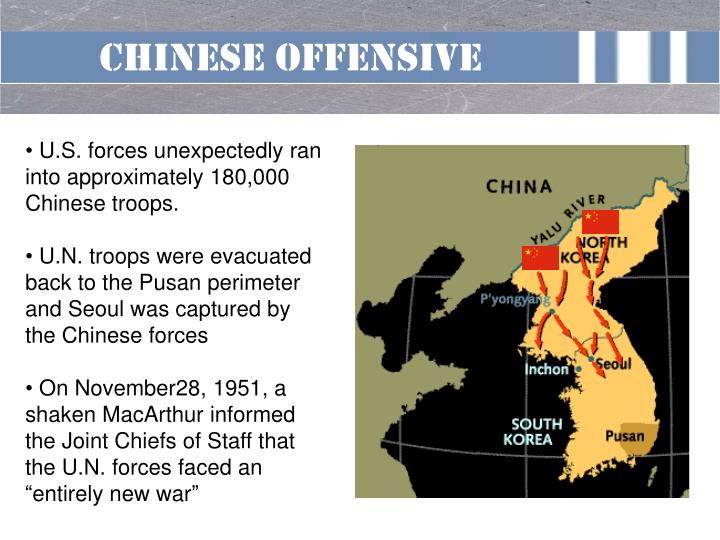
 www.youtube.com
www.youtube.com
US-led forces fall back to Pusan Perimeter and Seoul falls to China-led forces in the course.
PHASE 4
Detailed (visual) information in following links: https://history.army.mil/reference/Korea/KW-P4.pdf
US-led forces regroup in Pusan Perimeter and counter-attack to retake Seoul and additional areas along the 38th Parallel in a series of military operations under the command of General Mathew Ridgway (Operation Thunderbolt on January 25, 1951; Operation Killer on February 1, 1951; Operation Rugged on April 5, 1951; Operation Piledriver on May 18, 1951). China-led forces offer considerable resistance with counteroffensives of their own in the mix.

PHASE 5
Detailed information in the following link: https://history.army.mil/reference/Korea/KW-P5.pdf
Further clashes between belligerents continue along the 38th Parallel and an Armistice is reached on July 27, 1953 with re-adjusted Korean borders that are valid to this day.
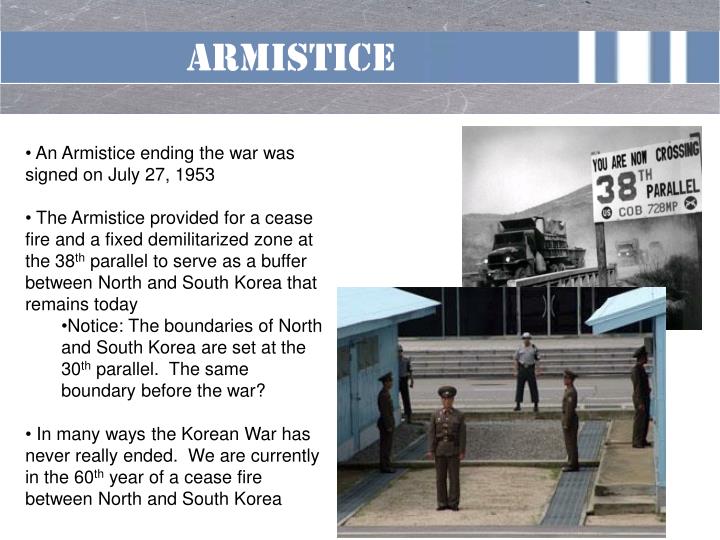
SUMMARY
REFERENCES
 www.jstor.org
www.jstor.org
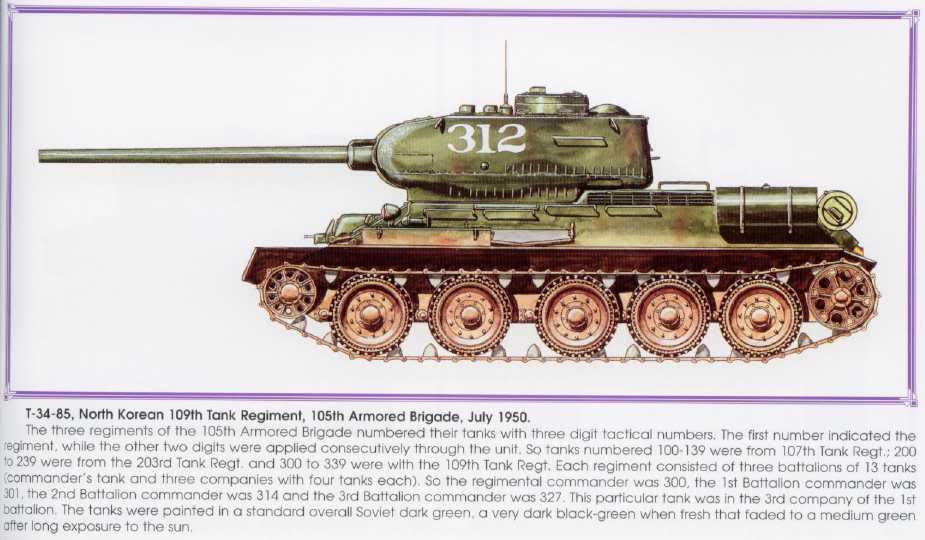
 weaponsandwarfare.com
weaponsandwarfare.com

 www.slideserve.com
www.slideserve.com

 www.sparknotes.com
www.sparknotes.com
North Korea and South Korea were split across the 38th parallel by USSR and USA after World War 2.

USSR helped transform North Korea into an organized communist state with well-equipped armed forces in the (1945 - 1950) period.

USA did not pay much attention to security needs of South Korea and reduced its footprint in the region to significant extent. In view of this development, Soviet Leader Joseph Stalin felt that South Korea can be taken by force and USA will not defend it.

American armed forces were also subject to downsizing back home:
Defense Technical Information Center
THE WAR
Broader perspective:
Tanker's perspective:

PHASE 1
Detailed (visual) information in following link: https://history.army.mil/reference/Korea/KW-P1.pdf
North Korea invade South Korea on June 25, 1950; much of South Korea is overrun in the span of some months.

North Korean army was in possession of T-34-85 main battle tank(s) in 1950 which was better than a number of American counterparts with the exception of M-26A1 Pershing at the time.
Tank Encyclopedia - The Online Tank Museum
All about the tactics, technologies, and evolution of the tank worldwide, from World War I to the Atomic and Digital Ages.
 tanks-encyclopedia.com
tanks-encyclopedia.com
North Korean army also fielded thousands of artillery pieces including katyusha rocket launchers to bombard enemy positions.
North Korean Air Force was equipped with battle-proven Yak-9 variants.
South Korean Pusan Perimeter was able to hold its ground nevertheless.

- YouTube
ÐивÑÑÑÑÑ Ð²Ñдео, ÑлÑÑайÑе ÑлÑÐ±Ð»ÐµÐ½Ñ Ð¼ÑзикÑ, заванÑажÑйÑе оÑигÑналÑний конÑÐµÐ½Ñ Ñ Ð´ÑлÑÑÑÑÑ Ð²ÑÑм Ñим Ñз дÑÑзÑми, ÑÑм'ÑÑ Ð¹ ÑÑлим ÑвÑÑом на YouTube.
PHASE 2
Detailed (visual) information in following link: https://history.army.mil/reference/Korea/KW-P2.pdf
US-led forces emerge in force and liberate South Korea under the command of General Douglas MacArthur; Operation Chromite is a masterstroke move on September 25, 1950 in relation.


How a surprise invasion deep behind enemy lines turned the tide in the US's first Cold War conflict
By September 1950, three months after North Korea invaded South Korea, Gen. Douglas MacArthur knew a bold plan was needed to relieve the pressure.
US-led forces rout North Korean military from South Korea, and invade North Korea after a gap of some days and approach Yalu River.

The role of heavy artillery in deployments of US-led forces for reference:
In response to deployment of the impressive F-86 variants by USAF in the region to defeat North Korean Air Force, USSR dispatched the impressive MiG-15 variants to the Korean front. This was the only war in history in which Soviet Air Force and USAF fought each other directly.
- YouTube
ÐивÑÑÑÑÑ Ð²Ñдео, ÑлÑÑайÑе ÑлÑÐ±Ð»ÐµÐ½Ñ Ð¼ÑзикÑ, заванÑажÑйÑе оÑигÑналÑний конÑÐµÐ½Ñ Ñ Ð´ÑлÑÑÑÑÑ Ð²ÑÑм Ñим Ñз дÑÑзÑми, ÑÑм'ÑÑ Ð¹ ÑÑлим ÑвÑÑом на YouTube.
PHASE 3
Detailed (visual) information in following link: https://history.army.mil/reference/Korea/KW-P3.pdf
China dispatch a massive army to liberate North Korea in a significant turn of events.

- YouTube
ÐивÑÑÑÑÑ Ð²Ñдео, ÑлÑÑайÑе ÑлÑÐ±Ð»ÐµÐ½Ñ Ð¼ÑзикÑ, заванÑажÑйÑе оÑигÑналÑний конÑÐµÐ½Ñ Ñ Ð´ÑлÑÑÑÑÑ Ð²ÑÑм Ñим Ñз дÑÑзÑми, ÑÑм'ÑÑ Ð¹ ÑÑлим ÑвÑÑом на YouTube.
US-led forces fall back to Pusan Perimeter and Seoul falls to China-led forces in the course.
PHASE 4
Detailed (visual) information in following links: https://history.army.mil/reference/Korea/KW-P4.pdf
US-led forces regroup in Pusan Perimeter and counter-attack to retake Seoul and additional areas along the 38th Parallel in a series of military operations under the command of General Mathew Ridgway (Operation Thunderbolt on January 25, 1951; Operation Killer on February 1, 1951; Operation Rugged on April 5, 1951; Operation Piledriver on May 18, 1951). China-led forces offer considerable resistance with counteroffensives of their own in the mix.

PHASE 5
Detailed information in the following link: https://history.army.mil/reference/Korea/KW-P5.pdf
Further clashes between belligerents continue along the 38th Parallel and an Armistice is reached on July 27, 1953 with re-adjusted Korean borders that are valid to this day.

SUMMARY
| Battlefield Outcome # 1 | US-led coalition liberated South Korea |
| Battlefield Outcome # 2 | China and USSR prevented downfall of North Korea |
| Final Outcome: | American mission to save South Korea is accomplished with Armistice Agreement for the Restoration of the South Korean State |
REFERENCES
Accept Terms and Conditions on JSTOR
JSTOR is a digital library of academic journals, books, and primary sources.

The North Korean Steamroller
NKPA T34-85 tanks on parade. For the invasion of South Korea seven NKPA divisions were gathered under General Kim Chaek and grouped into the 1st Army, consisting of the 1st, 3rd, 4th and 6th Divisi…
 weaponsandwarfare.com
weaponsandwarfare.com

PPT - L11: The Korean War: 1950-1953 American Foreign Policy PowerPoint Presentation - ID:2565225
L11: The Korean War: 1950-1953 American Foreign Policy. Agenda Objective : To understand the events of the Korean War. To analyze the significance of the Korean War for US foreign policy. Schedule : Lecture Discussion. Homework : Consult Unit Schedule for Background Reading.
Korean War Lsn ppt download
ID & SIG: Inchon, limited war, MacArthur, Pusan Perimeter, Seoul, Task Force Smith, United Nations, Chinese intervention
slideplayer.com

The Korean War (1950-1953): Brief Overview | SparkNotes
The Korean War (1950-1953) quiz that tests what you know about important details and events in the book.







